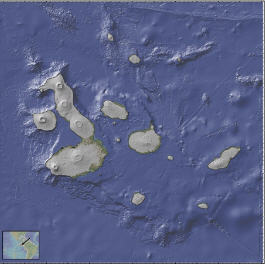How Have Changing Sea-Levels Influenced Evolution on the Galapagos Islands?

Writing in the Journal of Biogeography, Jason Ali and Jonathan Aitchison explore how fluctuating sea level changes over thousands of years impacted the island chain’s ecology.
They estimate that when the sea retreated, most recently 20,000 years ago, the water would have been 144m below its current level.
As a result, Santa Cruz, the island in the center of the archipelago, would have expanded, enveloping many of the smaller islands, while creating a series of shallow ‘land bridges’ between the volcanic outcroppings.
Such bridges explain the range and diversity of the islands' species, such as snakes, geckos and iguanas, which appear landlocked to modern eyes.
“As soon as I saw that that half the islands in the archipelago were sat on a single, shallow, submarine platform, I realized that the implications for biology could be significant,” said Dr. Ali.
“My geological knowledge told me that sea-level falls must have regularly re-connected the islands, and that this must have profoundly shaped the landlocked biota’s distribution, and very likely its composition.”
Media Contact
More Information:
http://eu.wiley.com/WileyCDA/PressRelease/pressReleaseId-110742.htmlAll latest news from the category: Earth Sciences
Earth Sciences (also referred to as Geosciences), which deals with basic issues surrounding our planet, plays a vital role in the area of energy and raw materials supply.
Earth Sciences comprises subjects such as geology, geography, geological informatics, paleontology, mineralogy, petrography, crystallography, geophysics, geodesy, glaciology, cartography, photogrammetry, meteorology and seismology, early-warning systems, earthquake research and polar research.
Newest articles

High-energy-density aqueous battery based on halogen multi-electron transfer
Traditional non-aqueous lithium-ion batteries have a high energy density, but their safety is compromised due to the flammable organic electrolytes they utilize. Aqueous batteries use water as the solvent for…

First-ever combined heart pump and pig kidney transplant
…gives new hope to patient with terminal illness. Surgeons at NYU Langone Health performed the first-ever combined mechanical heart pump and gene-edited pig kidney transplant surgery in a 54-year-old woman…

Biophysics: Testing how well biomarkers work
LMU researchers have developed a method to determine how reliably target proteins can be labeled using super-resolution fluorescence microscopy. Modern microscopy techniques make it possible to examine the inner workings…





















